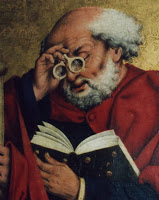Most D&D-based campaigns are set in a setting more or less analogous to Medieval Europe. We tend to think of such times are backward in the extreme, driven by media images such as Monty Python and the Holy Grail. However, the Medieval peoples had fairly sophisticated technology that we might not realize they had. Here are ten pieces of (mundane) technology that you might want to consider including in your campaign.
- Central Heating (9th century). Hot air was forced through channels beneath the floor. The Romans had something similar much earlier; the whole floor was raised above a small chamber filled with hot air (called a hypocaust).
- Mechanical Clock (13th century). Wound springs turn precision-made gears to move hands on the clock face.
- Magnetic Compass (13th century). Magnetized needle is placed on precision-floating pin, without needing to float on water. Magnets themselves are used as early as the mid-12th century.
- Eyeglasses (13th century). Convex lenses allow for correction of eye defects and magnification.
- Watermarks (13th century). Mark pressed into the paper itself helps prevent counterfeiting.
- Distilling (12th century). Distilled liquors were sometimes used for medicinal purposes.
- Liquid soap (9th century). Solid soap came later, in the 12th century.
- Cannons (13th century). Originally cannons were made with iron staves held in places by metal hoops. That’s why a gun’s muzzle is still called a “barrel” to this day.
- Paper (8th century). Much easier and cheaper to produce than papyrus, vellum, etc.
- Incendiary Grenades (9th century). Made with “Greek Fire”, a mixture of petroleum and bitumen that can burn even underwater.










Great post!
Are the 9th century grenades the 'Petard' type ones?
No, a petard used gunpowder rather than Greek fire, and came into use around the 16th century. Just a little later than I wanted for this particular post.
Another point, the general appearance of medieval life. Again, thanks to Hollywood and certain modern sensitivities, we tend to portray Medieval Europeans as muddy, grungy, dirty, in mud caked shacks and gray stone castles. But looking at contemporary art, the castles were quite impressive, whitewashed and gleaming with multi-colored roofs. The cottages were also similarly decorated, and most contemporary art – notwithstanding that art focused on death and dying – showed peasants well dressed, cared for, and generally better than most Hollywood treatments of the time. As one historian said, to come over a hill and see a white painted castle with banners flying and bright roofs shining in the sunlight would have been an impressive sight in any age.
An excellent point, Dave, and one that extends beyond Medieval Europe as well. The pyramids, for example, were once clad in white granite, which would have shone like a snow-covered mountain for miles away. And ancient Greek and Roman statuary was originally painted in lifelike tones, rather than being stark white. The ancient world was a lot more colorful than we sometimes imagine.
I love this kind of stuff! I remember reading that the Romans had 'eyeglasses' to help the elderly continue reading in old age. These were simple magnifying lenses cut from crystals and usually had a handle so they could be held in front of the face like a 19th century 'lorgnette.' And some of the aqueducts are still functional today — talk about good ideas!
The ancient Egyptians pioneered beer brewing technology, indoor plumbing and birth control — all things I would hate to live without.
"The Medieval Machine" by Jean Gimpel is a very good book on the subject. The Domesday Book of 1086 lists 5,624 water driven mills of various sorts in operation in the section of England covered by the survey.
Great post. The notion that many of us have about the medieval world is often skewed due to popular presentations that are accepted because "everybody just knows" that's how it was.
Along those same lines, the idea that people in the middle ages thought the earth was flat is a 19th century invention, as is seen in Jeffrey Burton Russell's "Inventing the Flat Earth."
Another great point, GM. What many people don't realize, in regards to Columbus, is that the court of Isabella and Ferdinand did not dispute that the Earth was a globe. Rather, they disputed Columbus's calculations as to the circumference of that globe.
And it turns out, Columbus was wrong. If North America hadn't gotten in his way, his expedition would have been an unmitigated failure. As it was, he didn't do what he set out to do. But history is kind to those whose mistakes turn out to be more valuable than their original goals…
Another excellent book on the topic is "Cathedral, Waterwheel, and Forge" by Joseph and Frances Gies. Honestly, pretty much anything they write on the medieval period is good, but that one is particularly appropriate for this topic.
A good book that gave me insights to Dark Ages/Feudal life was "The Year 1000" by Robert Lacey It's an interesting read. A bit earlier than your technology sweet spot, but I don't get the impression that peasant or rural life changed all that much from the 11th century to the 14th century.
Medieval…In my mind's eye the atmosphere of AD&D and most fantasy literature was always more compatible with the "ancient" world, or a "pre-ancient" world, but YMMV…
Egyptian "birth control" often involved crocodile dung, so I imagine it was more like avesion theapy than fertility control.